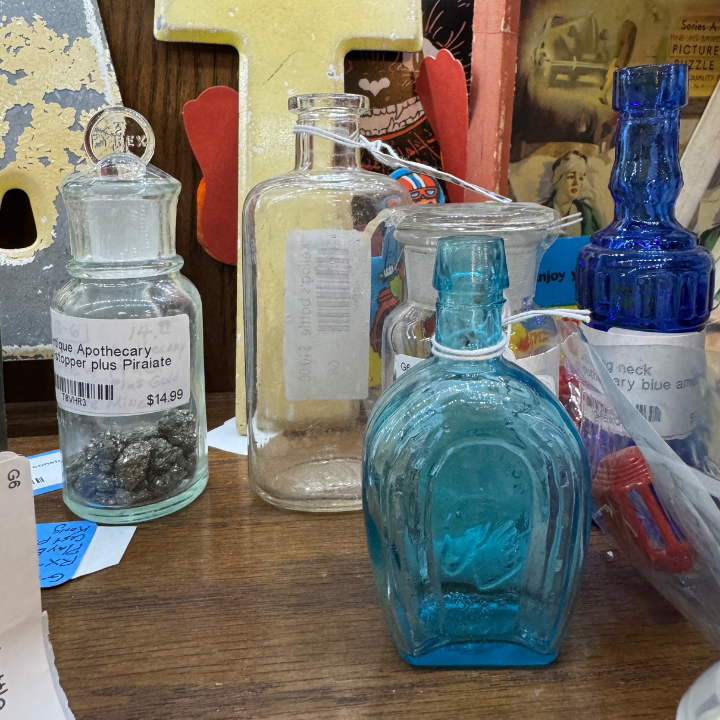A dusty glass bottle with a faded label. A porcelain jar with delicate gold lettering. A cobalt blue vial once filled with a mysterious elixir. Apothecary jars and vintage medicine bottles hold more than just remnants of the past—they tell a story of early medicine, craftsmanship, and evolving science.
Once a staple in pharmacies and home remedies, these vessels have now found a new life as collector’s items, decor pieces, and historical artifacts. In this blog, we’ll explore the history of apothecary jars and medicine bottles, the different styles that emerged over time, and how they can be incorporated into modern spaces.
1️⃣ The Origins of Apothecary Jars & Medicine Bottles
Long before modern pharmacies and over-the-counter medications, apothecaries were the trusted sources of medicine. Dating back to ancient civilizations, apothecaries combined science, herbal knowledge, and artistry to create remedies stored in carefully crafted jars and bottles.
🏺 Early Apothecary Jars (15th–18th Century)
- The earliest apothecary jars were ceramic or porcelain, used to store dried herbs, powders, and ointments.
- Italian maiolica jars (16th century) were highly decorative, often featuring hand-painted floral designs and Latin inscriptions.
- In the 17th and 18th centuries, Dutch Delftware and English stoneware became popular for their durability and artistic appeal.
💊 The Rise of Glass Medicine Bottles (19th Century–Early 20th Century)
- As glassmaking advanced, hand-blown and molded glass bottles replaced ceramic jars for liquid medicines and tonics.
- In the Victorian era, medicine bottles became smaller, portable, and mass-produced, often featuring embossed brand names and paper labels.
- The early 1900s saw the peak of “patent medicines”, with boldly labeled bottles promising cures for everything from headaches to nervous disorders.
2️⃣ Types of Antique Apothecary Jars & Medicine Bottles
Over the centuries, apothecaries and pharmacies used a variety of containers, each serving a distinct purpose.
🏺 Ceramic & Porcelain Apothecary Jars
- Used for storing herbs, powders, and ointments.
- Often hand-painted with intricate designs and Latin inscriptions.
- Common in European pharmacies during the Renaissance and Baroque periods.
💎 Cut & Colored Glass Medicine Bottles
- Cobalt blue and amber glass were used to protect light-sensitive medicines.
- Clear glass bottles were often used for tonics, syrups, and tinctures.
- Hand-blown glass bottles (pre-1850s) feature irregular shapes and pontil marks.
🔹 Poison Bottles (Mid-19th–Early 20th Century)
- Many featured skull and crossbones designs or raised lettering like “POISON” for safety.
- Often ridged or textured, so they could be identified by touch in the dark.
📝 Embossed & Labeled Patent Medicine Bottles
- Highly collectible, these bottles were used for commercialized “cure-all” remedies.
- Many featured elaborate paper labels boasting health claims.
3️⃣ Collecting & Identifying Vintage Medicine Bottles
If you’re interested in collecting antique apothecary jars and medicine bottles, here are a few key things to look for:
🔍 Signs of Authenticity & Age
✔ Pontil Marks – A rough, circular mark on the base of early hand-blown glass bottles.
✔ Seams & Mold Lines – Bottles with no seams or hand-tooled tops are pre-1860. Molded bottles with distinct seams date from the late 19th century onward.
✔ Embossed Names & Logos – Many 19th and early 20th-century bottles feature raised lettering indicating the pharmacy or manufacturer.
🛑 Beware of Reproductions!
- Many decorative apothecary jars are modern imitations. Look for signs of hand-painting, age wear, and authentic pottery or glass marks.
- Some vintage-style poison bottles are reproductions made for Halloween decor—check for authentic mold seams and manufacturer stamps.
4️⃣ How to Use Apothecary Jars & Medicine Bottles in Decor
Even if you’re not an antique collector, vintage apothecary jars and bottles make gorgeous and functional decor pieces!
🏡 Rustic Kitchen Storage – Use old ceramic apothecary jars to store spices, sugar, or coffee beans.
🛁 Bathroom Accents – Display antique glass medicine bottles with cotton swabs, bath salts, or fresh flowers.
📚 Bookshelf Styling – Arrange cobalt blue bottles alongside vintage books and curiosities.
🎃 Seasonal Displays – Poison bottles make great Halloween decor, while glass jars filled with fairy lights add a magical touch.
💡 DIY Centerpieces – Turn vintage glass bottles into vases for wildflowers or dried herbs.
5️⃣ Are Antique Apothecary Jars & Bottles Valuable?
💰 Yes! Certain rare pieces can fetch high prices among collectors.
- Rare 17th-century apothecary jars with hand-painted Latin inscriptions can sell for hundreds to thousands of dollars.
- Poison bottles with unique embossing or color (e.g., deep turquoise or green) are highly desirable.
- Embossed patent medicine bottles from well-known brands like Dr. Kilmer’s Swamp Root, Lydia Pinkham’s Herbal Compound, or Ayer’s Cherry Pectoral are always in demand.
The Enduring Appeal of Apothecary Jars & Vintage Medicine Bottles
Whether you collect them for their history, beauty, or quirky charm, antique apothecary jars and vintage medicine bottles are fascinating artifacts that connect us to the past. From early pharmacists mixing remedies to Victorian patent medicine advertising, these pieces remind us of a time when science, art, and everyday life intertwined.
✨ Do you have a favorite vintage medicine bottle or apothecary jar? Share your finds in the comments! 🏺💙





1 comment
I wish you had a sample picture of each of these jars. I don’t know how hard it is to gather these pictures. I am assuming very hard on some real old ones and easy on newer kind i guess. But, Thanks for the great article and work you did.